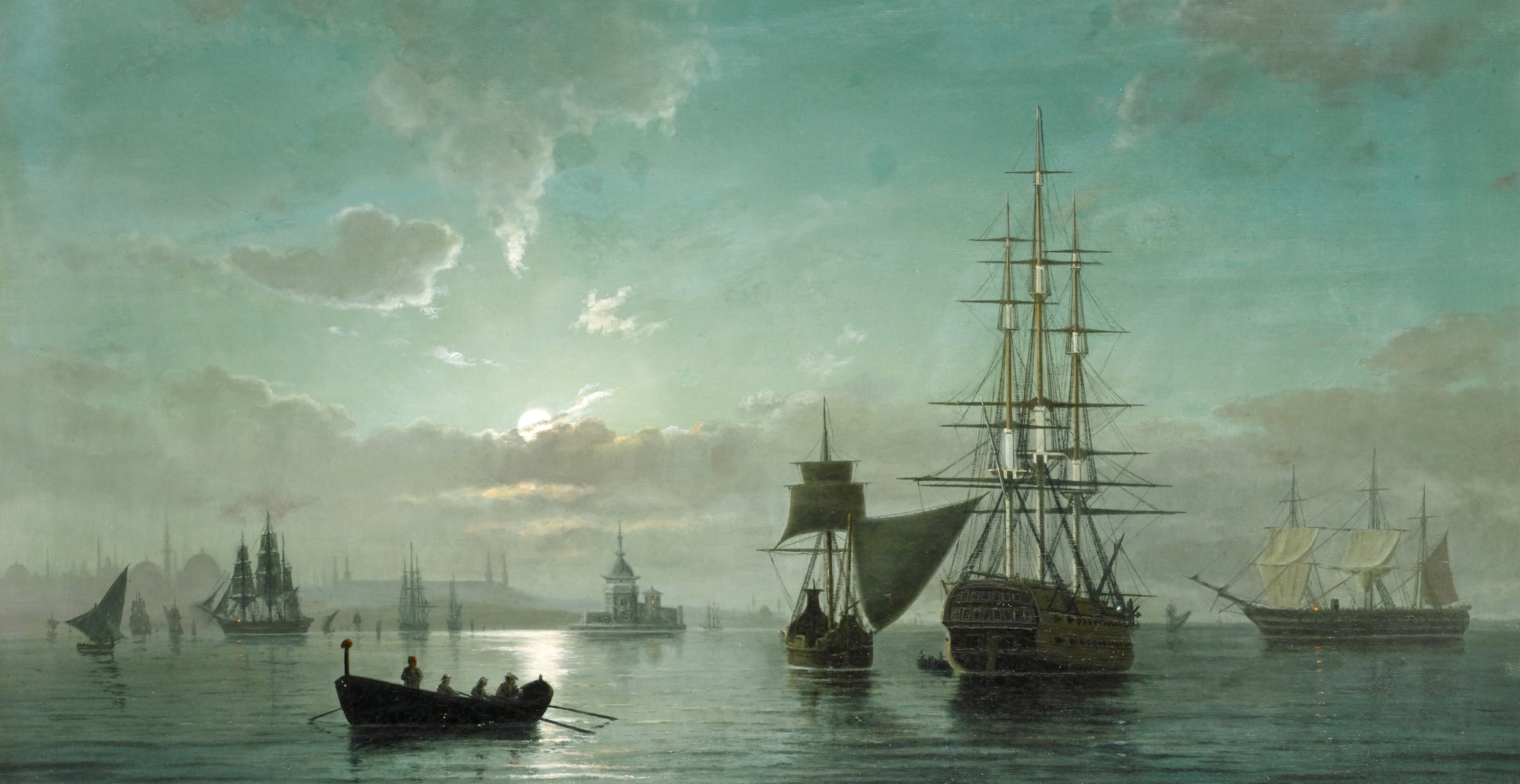mile Valentin
(French - 19 th Century )
Ships at Night, Constantinople
signed, inscribed and dated ‘Emile. Valentin./ Constantinople. 1877.’ (lower right)
oil on canvas
53.5 x 84 cm (21⅛ x 33 in)
Ships at night, Constantinople depicts the magnificent vista of Constantinople and the Bosphorus lit by shimmering moonlight. The sky is dramatically illuminated by a vivid moon; the water below is calm and tranquil. The waterway is alive with various maritime activities despite the late hour. In the right foreground a British two-decker sits at anchor whilst a small rowing boat docks alongside. Immediately to the left, a smaller sailboat amends its headsail. A steam powered two-decker enters the harbour in the right-hand background, the faint orange glow of its beacon reflected in the still waters. The left foreground is dominated by a row boat cutting its way across the iridescent moonlight of the Bosphorus. Inside the boat are four figures, two equipped with oars, who head towards the anchored two-decker. In the background of the composition, the silhouetted skyline of Constantinople is readily identifiable. One can distinguish the numerous domes, minarets and towers that fleck the darkened and misty horizon, whilst the harbour is littered with various craft, both Turkish and foreign, entering and leaving the waterway.
To the right of the city, the Tower of Leander (Maiden’s Tower or Kız Kulesi) is readily identifiable, a warm glow radiating from a window of the smaller tower. Situated on a small islet on the Bosphorus strait, the tower was first built by the ancient Athenian general Alcibiades in 408 b.c. to control the movements of the Persian ships in the waterway. The tower was later enlarged and rebuilt as a fortress by the Byzantine emperor Alexius Comnenus in 1110 a.d., and was rebuilt and restored several times by the Ottoman Turks, most significantly in 1509 and 1763. For many centuries the tower was used as a lighthouse to help prevent naval accidents occurring in the narrow straits.
Little is known about the life of Emile Valentin; however, this work shows clear associations with the work of Ivan Konstantinovich Aivazovsky (1817-1900). Aivazovsky was a Russian artist famed for his dramatic seascapes. Born in Crimea to a family of Armenian origin, he studied at the St. Petersburg Academy of Arts where he specialised in marine landscapes. He was awarded the title of Academician in 1844 and subsequently became attached to the General Naval Headquarters. This post enabled him to travel frequently with the Russian fleet on different missions and during this period he visited Turkey, Greece, Egypt and America. It is therefore possible that Valentin either met or was aware of Aivazovsky’s work while the two artists were visiting Turkey. For example, Aivazovsky's View of Constantinople by Moonlight shows Constantinople similarly bathed in moonlight whilst the skyline is dominated by the silhouetted city and naval activity. In both Ships at night, Constantinople and View of Constantinople by Moonlight, the radiating moon is central to the composition in order to create changing areas of light, tone and nocturnal mystique.
Ships at night, Constantinople depicts the magnificent vista of Constantinople and the Bosphorus lit by shimmering moonlight. The sky is dramatically illuminated by a vivid moon; the water below is calm and tranquil. The waterway is alive with various maritime activities despite the late hour. In the right foreground a British two-decker sits at anchor whilst a small rowing boat docks alongside. Immediately to the left, a smaller sailboat amends its headsail. A steam powered two-decker enters the harbour in the right-hand background, the faint orange glow of its beacon reflected in the still waters. The left foreground is dominated by a row boat cutting its way across the iridescent moonlight of the Bosphorus. Inside the boat are four figures, two equipped with oars, who head towards the anchored two-decker. In the background of the composition, the silhouetted skyline of Constantinople is readily identifiable. One can distinguish the numerous domes, minarets and towers that fleck the darkened and misty horizon, whilst the harbour is littered with various craft, both Turkish and foreign, entering and leaving the waterway.
To the right of the city, the Tower of Leander (Maiden’s Tower or Kız Kulesi) is readily identifiable, a warm glow radiating from a window of the smaller tower. Situated on a small islet on the Bosphorus strait, the tower was first built by the ancient Athenian general Alcibiades in 408 b.c. to control the movements of the Persian ships in the waterway. The tower was later enlarged and rebuilt as a fortress by the Byzantine emperor Alexius Comnenus in 1110 a.d., and was rebuilt and restored several times by the Ottoman Turks, most significantly in 1509 and 1763. For many centuries the tower was used as a lighthouse to help prevent naval accidents occurring in the narrow straits.
Little is known about the life of Emile Valentin; however, this work shows clear associations with the work of Ivan Konstantinovich Aivazovsky (1817-1900). Aivazovsky was a Russian artist famed for his dramatic seascapes. Born in Crimea to a family of Armenian origin, he studied at the St. Petersburg Academy of Arts where he specialised in marine landscapes. He was awarded the title of Academician in 1844 and subsequently became attached to the General Naval Headquarters. This post enabled him to travel frequently with the Russian fleet on different missions and during this period he visited Turkey, Greece, Egypt and America. It is therefore possible that Valentin either met or was aware of Aivazovsky’s work while the two artists were visiting Turkey. For example, Aivazovsky's View of Constantinople by Moonlight shows Constantinople similarly bathed in moonlight whilst the skyline is dominated by the silhouetted city and naval activity. In both Ships at night, Constantinople and View of Constantinople by Moonlight, the radiating moon is central to the composition in order to create changing areas of light, tone and nocturnal mystique.





 contact
contact contact
contact +44 20 7313 8040
+44 20 7313 8040









